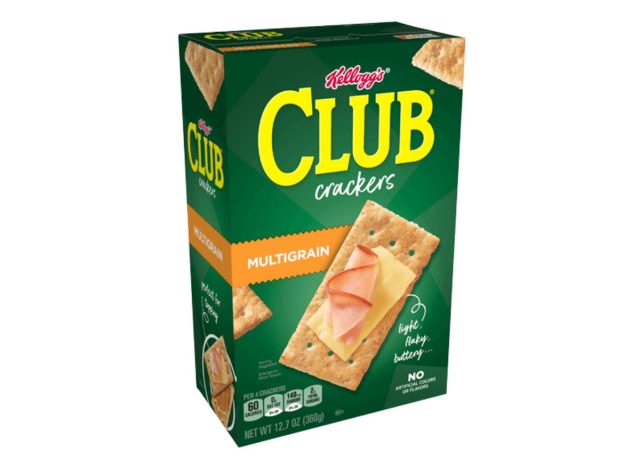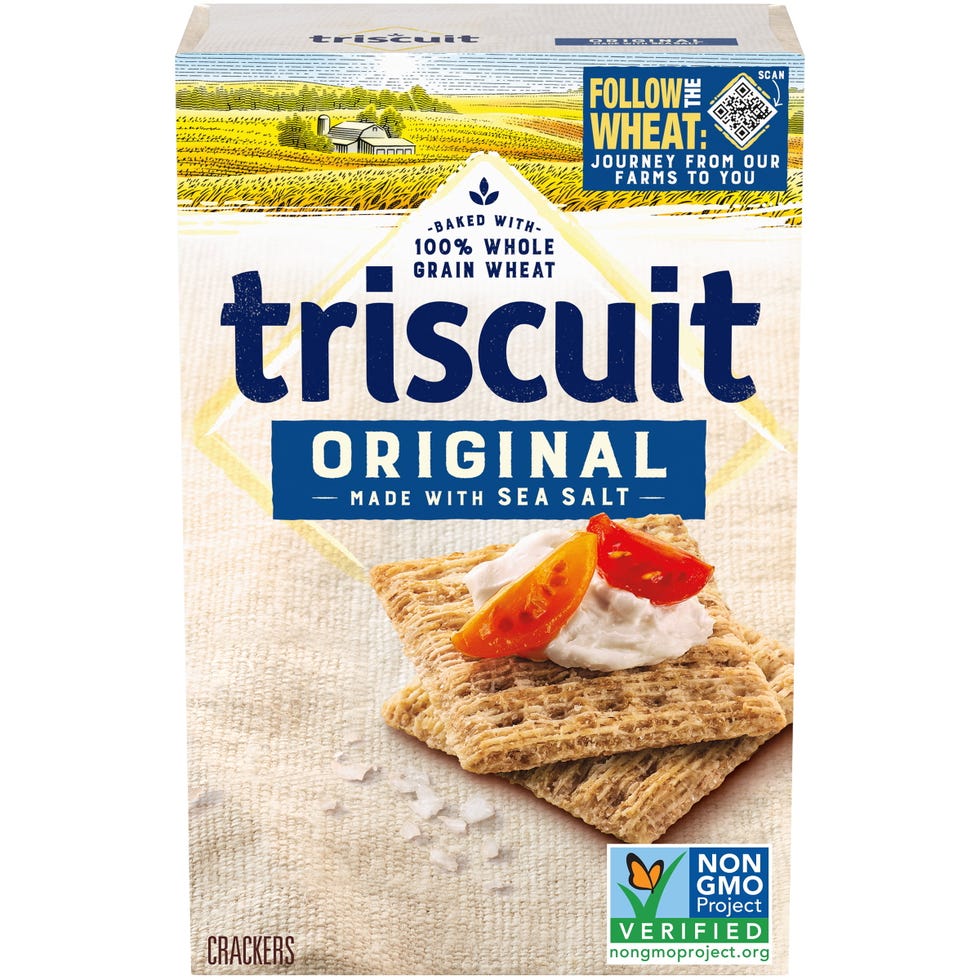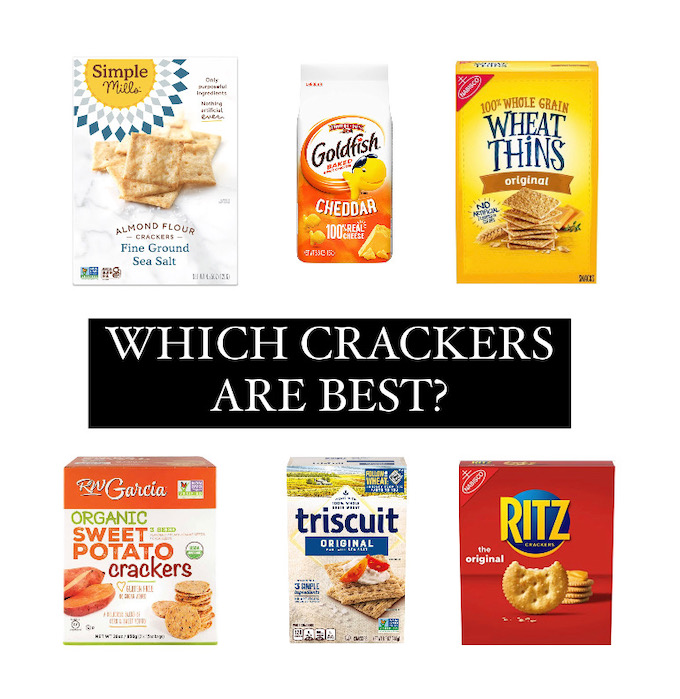What is a Healthy Cracker to Eat is made from whole grains and has minimal added sugars and unhealthy fats. Look for options high in fiber and low in sodium.
Choosing the right snack is crucial for maintaining a balanced diet. Healthy crackers provide a nutritious alternative to traditional snacks. They are made from whole grains like oats, quinoa, or whole wheat. These crackers offer essential nutrients such as fiber, vitamins, and minerals.
Avoid crackers loaded with artificial flavors, excessive salt, or unhealthy fats. Opt for those with simple, recognizable ingredients. Healthy crackers can help keep you full and energized throughout the day. Pair them with nutritious toppings like hummus, avocado, or low-fat cheese for a satisfying snack. Make smart choices to support your overall health and well-being.

Credit: www.eatthis.com
Introduction To Healthy Snacking
What is a Healthy Cracker to Eat? Healthy snacking is important for maintaining energy levels throughout the day. Choosing the right snacks can help you stay full and satisfied. Crackers are a popular snack, but not all are healthy. Knowing what to look for can help you make better choices.
The Role Of Crackers
Crackers are a convenient and tasty snack. They can be paired with cheese, hummus, or eaten alone. Many crackers are made from refined flour and added sugars. These can lead to unhealthy eating habits.
| Common Cracker Ingredients | Health Impact |
|---|---|
| Refined Flour | Low in nutrients |
| Added Sugars | Can lead to weight gain |
| Artificial Additives | May cause health issues |
Shifting Towards Healthier Options
Making healthier cracker choices is easy with some tips. Look for whole grain crackers which provide more nutrients and fiber. Fiber helps keep you full longer.
- Choose crackers with minimal ingredients.
- Avoid crackers with added sugars and artificial additives.
- Check for healthy fats like olive oil or flaxseed.
Here are some healthy cracker options:
- Whole grain crackers
- Seed-based crackers
- Crackers made with legumes
Healthy crackers can be a part of a balanced diet. Enjoy them in moderation for the best benefits. Happy snacking!

Credit: www.prevention.com
Nutritional Components Of A Healthy Cracker
What is a Healthy Cracker to Eat? Choosing a healthy cracker can be confusing. Many options are available on the market. Understanding the nutritional components is crucial. This helps make an informed choice.
Key Ingredients
Healthy crackers contain simple, wholesome ingredients. Here are some key ingredients to look for:
- Whole grains: Whole wheat, oats, and quinoa are good choices.
- Seeds: Flaxseeds, chia seeds, and sesame seeds add nutrients.
- Nuts: Almonds, walnuts, and pecans provide healthy fats.
- Natural sweeteners: Honey or maple syrup instead of sugar.
These ingredients provide essential nutrients. They help keep you full longer. Avoid crackers with refined grains and artificial additives.
Understanding Labels
Reading labels is essential for choosing healthy crackers. Look for these on the label:
| Component | What to Look For |
|---|---|
| Fiber | At least 3 grams per serving |
| Sugar | Less than 2 grams per serving |
| Sodium | Less than 200 mg per serving |
| Protein | At least 2 grams per serving |
Choose crackers with minimal ingredients. This ensures they are free from preservatives and artificial flavors. Always check for whole grains as the first ingredient.
Whole Grains: The Foundation
Whole grains are the best base for healthy crackers. They provide essential nutrients and promote overall health. Whole grains include every part of the grain: bran, germ, and endosperm.
Benefits Of Whole Grains
What is a Healthy Cracker to Eat? Whole grains offer many health benefits. They are rich in fiber, vitamins, and minerals. Eating whole grains can help with digestion. They also reduce the risk of heart disease.
Whole grains can help you stay full longer. This can aid in weight management. They also have antioxidants, which fight free radicals.
Best Whole Grain Choices
Choose whole grain crackers for the best health benefits. Here are some top choices:
- Oats: High in fiber and good for heart health.
- Quinoa: Contains all nine essential amino acids.
- Brown Rice: Rich in magnesium and selenium.
- Whole Wheat: Packed with vitamins and minerals.
- Barley: Great source of fiber and protein.
| Whole Grain | Key Nutrients | Health Benefits |
|---|---|---|
| Oats | Fiber, Protein | Heart Health |
| Quinoa | Protein, Iron | Muscle Repair |
| Brown Rice | Magnesium, Selenium | Bone Health |
| Whole Wheat | Fiber, Vitamins | Digestive Health |
| Barley | Fiber, Protein | Weight Management |
Low Sodium Options
Choosing low sodium options is crucial for maintaining heart health. Many crackers are high in salt, which can lead to health issues. This section explores low sodium crackers for a healthier snack choice.
Importance Of Low Salt
High salt intake can raise blood pressure. It puts stress on the heart and arteries. Reducing salt helps prevent heart disease and stroke. Low sodium crackers are a tasty way to cut down on salt.
Top Picks For Low Sodium Crackers
Below are some top choices for low sodium crackers that you can enjoy without worrying about your salt intake:
| Brand | Cracker Name | Sodium (mg) per serving |
|---|---|---|
| Triscuit | Reduced Fat | 50 |
| Mary’s Gone Crackers | Original | 180 |
| Simple Mills | Almond Flour Crackers | 140 |
| Wasa | Light Rye | 70 |
| Back to Nature | Harvest Whole Wheat | 85 |
These crackers offer a tasty and healthier alternative. They are perfect for snacking without the extra salt. Look for these brands next time you shop for crackers.
- Triscuit Reduced Fat: Only 50 mg of sodium per serving.
- Mary’s Gone Crackers Original: Gluten-free with 180 mg sodium.
- Simple Mills Almond Flour Crackers: Made with nut flour, 140 mg sodium.
- Wasa Light Rye: Crisp and light with only 70 mg sodium.
- Back to Nature Harvest Whole Wheat: Whole grain goodness, 85 mg sodium.
Choosing low sodium crackers can be easy and delicious. These options help you snack smarter without sacrificing taste.
Fiber-rich Crackers
Fiber-rich crackers are great for your health. They help with digestion and keep you feeling full longer. Learn how to choose the best fiber-rich crackers for your diet.
Fiber’s Role In Diet
Fiber is essential for a healthy diet. It helps to keep your digestive system running smoothly. It also helps to control your blood sugar levels.
There are two types of fiber: soluble and insoluble. Soluble fiber dissolves in water and helps to lower cholesterol. Insoluble fiber helps to move food through your digestive system.
Eating enough fiber can help you avoid constipation. It also helps to lower your risk of certain diseases.
Selecting High-fiber Crackers
Choosing the right crackers can be tricky. Look for crackers with at least 3 grams of fiber per serving.
| Brand | Fiber Content | Ingredients |
|---|---|---|
| Brand A | 5 grams | Whole wheat, flax seeds |
| Brand B | 4 grams | Oats, chia seeds |
| Brand C | 3 grams | Brown rice, quinoa |
Check the ingredient list for whole grains. Whole grains are an excellent source of fiber. Avoid crackers with refined grains and added sugars.
- Whole wheat
- Oats
- Brown rice
- Quinoa
These ingredients will ensure your crackers are healthy and fiber-rich. Always read the nutrition label to make an informed choice.
Avoiding Unhealthy Additives
Eating healthy crackers is a great snack choice. But it’s important to avoid unhealthy additives. These additives can make crackers less healthy. Let’s learn how to avoid them.
Common Additives To Avoid
Some additives are bad for your health. Here are some common additives to avoid:
- Artificial Colors: These can cause allergies and hyperactivity.
- Artificial Flavors: They can be harmful to your body.
- Preservatives: These keep crackers fresh but can be unhealthy.
- High Fructose Corn Syrup: This is a type of sugar that can cause weight gain.
- Trans Fats: These fats are bad for your heart.
Reading Labels For Additives
What is a Healthy Cracker to Eat? It’s important to read labels before buying crackers. Here are some tips for reading labels:
- Check the Ingredient List: Look for any harmful additives.
- Avoid Long Lists: A long list of ingredients often means more additives.
- Look for Whole Ingredients: Choose crackers with whole grains and seeds.
- Watch for Hidden Sugars: Sugar can be listed under many names like sucrose or syrup.
By avoiding unhealthy additives, you can enjoy healthier crackers. Always read labels and choose wisely!
Gluten-free And Other Dietary Considerations
Understanding gluten-free and other dietary considerations is essential for finding the perfect healthy cracker. Many people have specific dietary needs, and choosing the right cracker can be challenging. This section will guide you through gluten-free choices and other dietary restrictions.
Choosing Gluten-free
Many healthy crackers are available in gluten-free versions. These crackers are made from alternative flours. Common options include almond flour, coconut flour, and rice flour.
Here is a table showcasing popular gluten-free flours:
| Gluten-Free Flour | Benefits |
|---|---|
| Almond Flour | Rich in protein and healthy fats |
| Coconut Flour | High in fiber and low in carbs |
| Rice Flour | Neutral taste and versatile |
Choose crackers with simple ingredients. Avoid those with artificial additives. Always check labels for hidden gluten ingredients.
Accommodating Other Dietary Restrictions
Besides gluten-free, there are other dietary needs. These include vegan, low-carb, and nut-free options.
- Vegan: Look for crackers without animal products. Ingredients should include seeds and grains.
- Low-Carb: Choose crackers made with almond or coconut flour. These have fewer carbs compared to traditional options.
- Nut-Free: Select crackers made from seeds or grains like quinoa. Always check for cross-contamination warnings on labels.
Here is a quick checklist for identifying suitable healthy crackers:
- Check for gluten-free certification.
- Read ingredient lists for allergens.
- Opt for products with minimal processing.
Healthy crackers can fit into various dietary plans. Always read labels to ensure they meet your specific needs.
:max_bytes(150000):strip_icc()/crackers-crop-ee53c89d8ac9422a8af2385a12ab21c1.jpg)
Credit: www.verywellfit.com
Top Healthy Cracker Recommendations
Everyone loves a good cracker. But not all crackers are healthy. Let’s explore the top healthy cracker recommendations. Discover brands and homemade options that are good for you.
Brands To Look For
Several brands offer healthy crackers. These crackers are low in sugar and high in fiber.
| Brand | Key Benefits |
|---|---|
| Mary’s Gone Crackers | Organic, gluten-free, high in fiber |
| Simple Mills | Made with almond flour, low in carbs |
| Wasa | Whole grain, low in calories |
Making Your Own Healthy Crackers
What is a Healthy Cracker to Eat? Making your own crackers can be easy and fun. You control the ingredients, ensuring they are healthy.
- Gather Ingredients: Whole wheat flour, seeds, olive oil, and water.
- Mix Dough: Combine flour, seeds, oil, and water into a dough.
- Roll and Cut: Roll out the dough and cut into cracker shapes.
- Bake: Bake at 350°F for 15 minutes.
Homemade crackers can be stored in an airtight container. They stay fresh for up to a week.
Frequently Asked Questions
What Type Of Crackers Are The Healthiest?
Whole grain crackers are the healthiest. They offer more fiber and nutrients. Opt for those with minimal added sugars and artificial ingredients.
What Cracker Is Good For Health?
Whole grain crackers are good for health. They contain fiber, vitamins, and minerals that support digestion and heart health.
Are Triscuits A Healthy Cracker?
Yes, Triscuits are a healthy cracker option. They are made from whole grain wheat, providing fiber and minimal ingredients.
What Kind Of Crackers Can I Eat If I’m On A Diet?
Choose whole grain, low-sodium crackers. Opt for options high in fiber and protein. Look for minimal added sugars and healthy ingredients.
Conclusion
Choosing a healthy cracker can significantly impact your diet. Opt for options high in fiber and low in sugar. Ingredients like whole grains, seeds, and minimal additives are ideal. By making informed choices, you can enjoy a tasty snack while maintaining your health goals.
Remember, healthy eating starts with smart decisions.




Leave a Reply